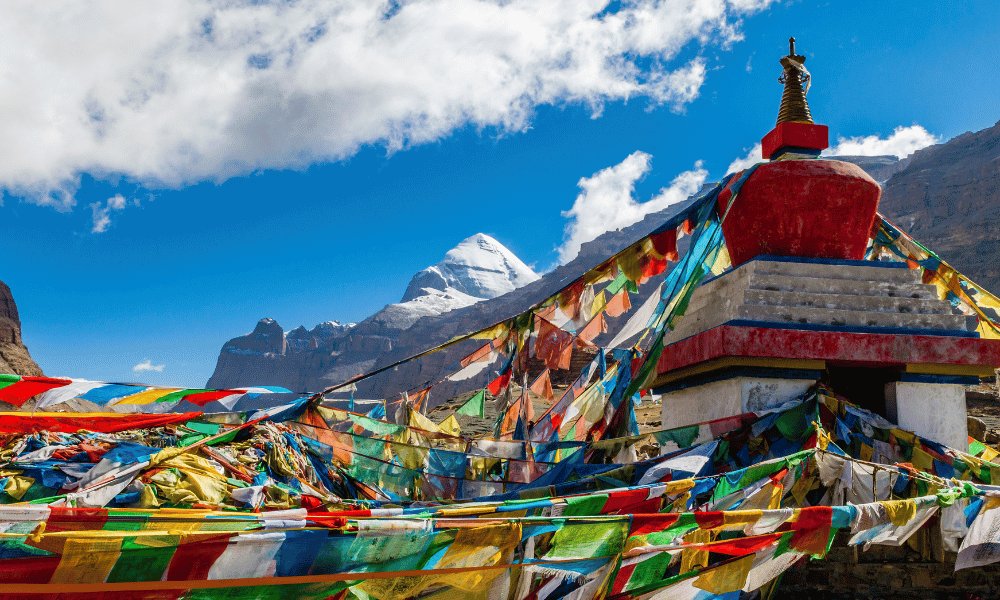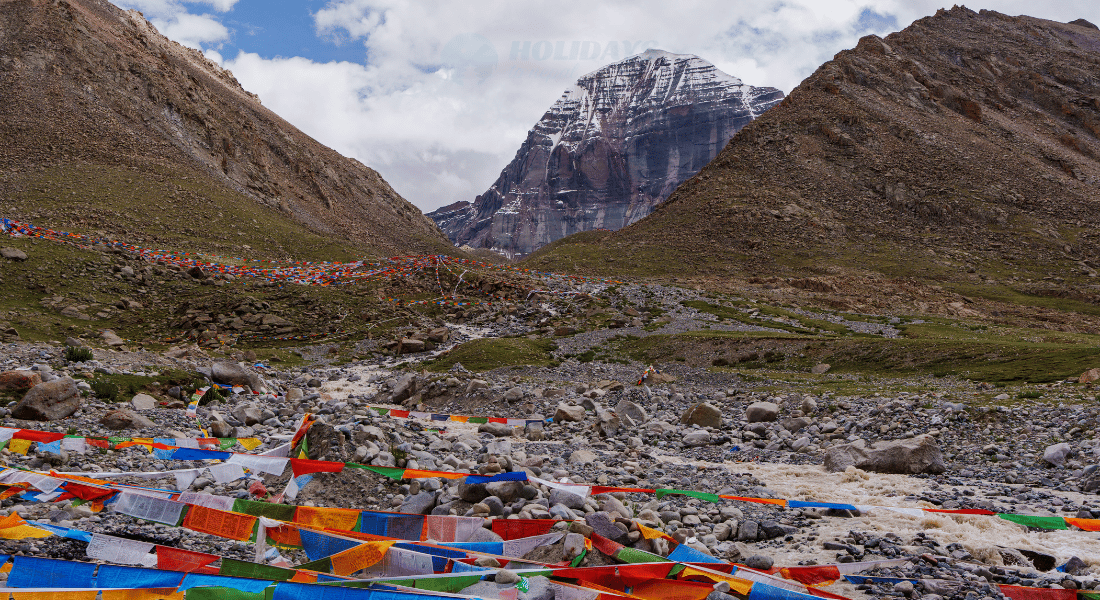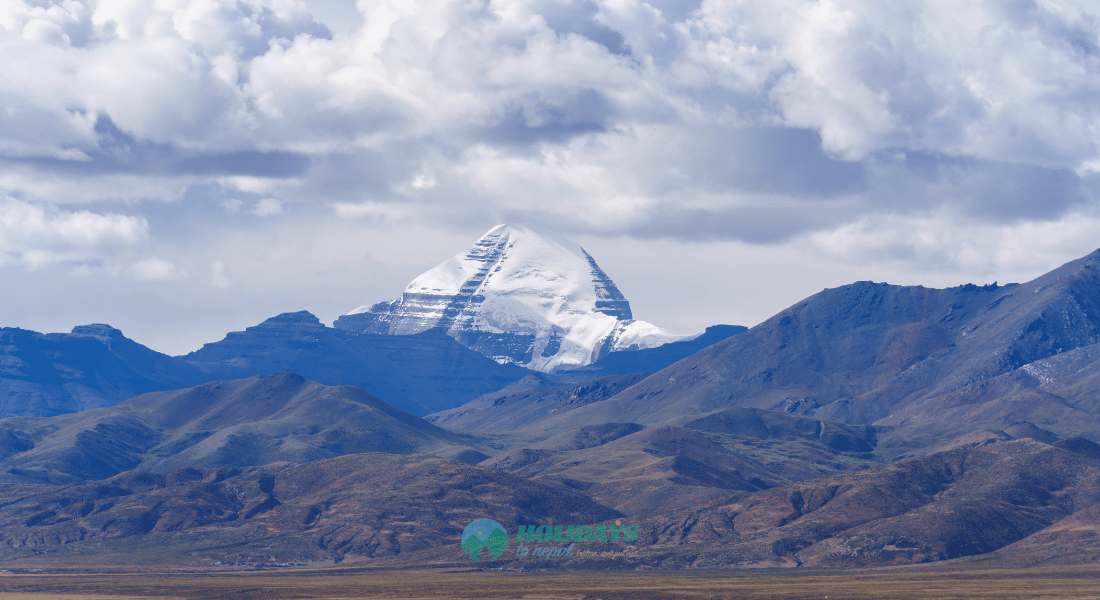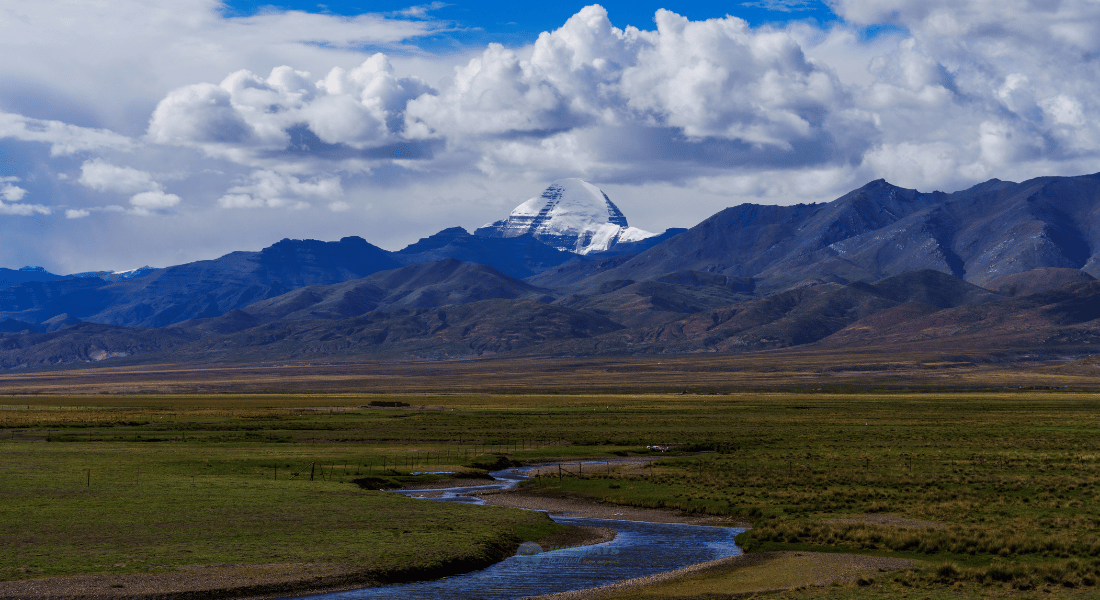The Kailash Mansarovar Yatra is an extraordinary spiritual pilgrimage that takes place in the remote and beautiful landscapes of Tibet. Mount Kailash, standing majestically at an altitude of 6,638 meters, is the central highlight of this journey. It is considered a sacred place in four religions: Hinduism, Buddhism, Jainism, and Bon.
Adjacent to Mount Kailash lies the stunning Mansarovar Lake, known for its surreal beauty and tranquil waters that stretch over a vast area. The journey to these divine places, generally undertaken by foot or on a yak, involves a strenuous trek and can take up to two weeks to complete, encompassing a total distance of around 52 kilometers. The pilgrims follow a circular path around Mount Kailash, a practice known as Kora or Parikrama.
Importance and Spiritual Significance of Kailash Mansarovar Yatra
-
Hinduism: In Hindu belief, Mount Kailash is considered the eternal abode of Lord Shiva and his consort Parvati. It is said that anyone who completes the Kailash Mansarovar Yatra with complete devotion achieves salvation and is liberated from the cycle of birth and death.
-
Buddhism: Tibetan Buddhists regard Mount Kailash as the home of the Buddha Demchok, a deity symbolizing supreme bliss. They believe circumambulating the mountain helps in attaining enlightenment.
-
Jainism: Jains consider Mount Kailash to be the site where the first Jain Tirthankara, Rishabhanatha, achieved liberation from the cycle of rebirth and death.
-
Bon: For followers of Bon, the indigenous religion of Tibet, Kailash is believed to be the sacred nine-story Swastika Mountain that leads to the heavens.
Completing the Kailash Mansarovar Yatra is not merely a test of physical endurance but also a journey of spiritual transformation. It is regarded as one of the most sacred and challenging pilgrimages in the world. Pilgrims return from the journey often describing a sense of spiritual awakening, renewal, and a deeper understanding of their faith.
Geography of Kailash Mansarovar
Situated in the heart of the Himalayan ranges in Tibet, the geography of Kailash Mansarovar is as complex as it is stunning. Mount Kailash, the central focal point of this area, stands majestically at an altitude of 6,638 meters. Its four faces correspond to the cardinal points (north, south, east, and west) and are made of different geological materials, giving each a unique appearance. It's notable for its striking near-symmetry and its lone, undisturbed presence amidst the vast Tibetan plateau.

The Mansarovar Lake lies approximately 20 kilometers southeast of Mount Kailash. It's one of the highest freshwater lakes in the world, sitting at an impressive altitude of approximately 4,590 meters. The lake covers a vast area, stretching for roughly 88 kilometers in perimeter, with depths reaching up to 90 meters. It's surrounded by scenic landscapes of the Tibetan plateau, with glimpses of the high Himalayan peaks in the distance.
Climatic Conditions of Kailash Mansarovar
The climate of the Kailash Mansarovar region is typically alpine and cold due to its high altitude. There is a significant variation in temperature during the day and night. The weather also changes quite dramatically across seasons.
-
Winter (Late October to Early March): During the winter months, the region is practically inaccessible due to heavy snowfall and extremely cold temperatures, which can drop below -15°C. The roads leading to Kailash Mansarovar are usually closed due to adverse weather conditions.
-
Spring (March to May): Springtime brings slightly warmer temperatures, ranging between -5°C to 10°C. The snow starts melting, and by late spring, the roads usually open up for the Yatra.
-
Summer (June to August): The summer months are considered the best time to visit Kailash Mansarovar. Temperatures can reach up to 15°C in the daytime but can still drop to 0°C or less during the night. This is also the monsoon period, with chances of sporadic rain and cloud cover.
-
Autumn (September to early October): The weather in autumn is relatively stable but begins to cool down rapidly. Daytime temperatures can vary from 5°C to 15°C, and nighttime temperatures can drop below 0°C. The region begins preparing for the winter, and by mid-October, the Yatra usually closes for the season.
It's important to note that the weather in the Himalayas can be unpredictable. Sudden changes in weather conditions can occur, including unseasonal snowfall or storms. Therefore, proper preparation and regular weather checks are essential for those planning the Yatra.
Seasonal Breakdown of Kailash Mansarovar Yatra
As you start planning your Kailash Mansarovar Yatra, go through the following seasonal breakdown to know what season suits the best for your trip. Keep weather conditions, your personal goals, and accessibility into consideration while working on the plan.
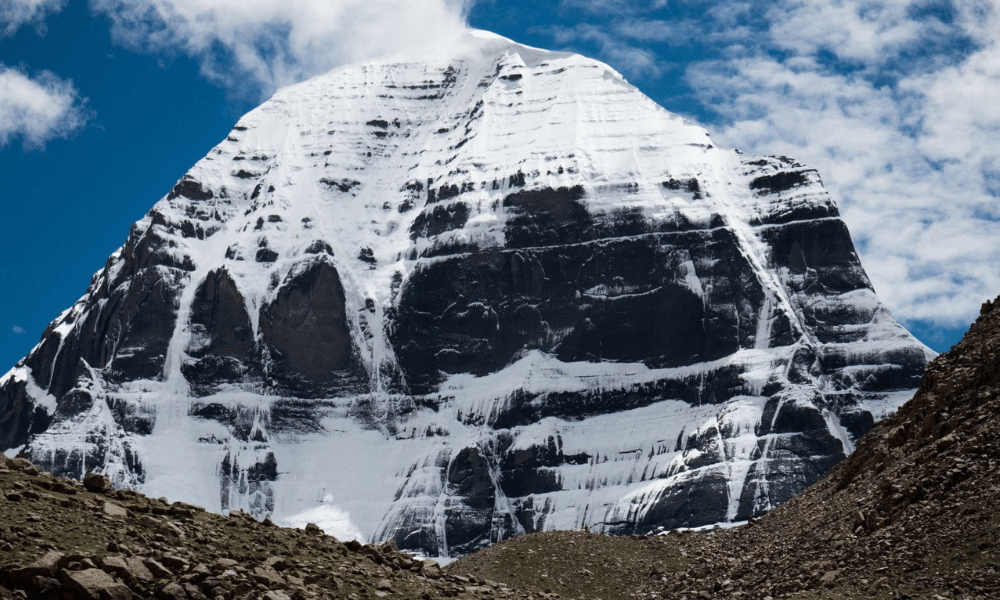
Winter (Late October to Early March)
Weather Conditions: During the winter months, the Kailash Mansarovar region is severely cold with temperatures plummeting well below -15°C. The area experiences heavy snowfall, making the trekking routes and roads inaccessible.
Pros:
-
The winter landscape, though harsh, offers unparalleled beauty for those able to withstand the cold.
Cons:
-
The Yatra is typically closed during this period due to the extreme weather conditions.
-
The risks associated with the harsh climate and heavy snowfall make it nearly impossible and highly dangerous to attempt the Yatra during winter.
Spring (March to May)
Weather Conditions: The spring season sees temperatures range from -5°C to 10°C. The snow begins to melt, gradually making the routes accessible.
Pros:
-
As the snow melts, the region starts to bloom, providing a picturesque setting for the Yatra.
-
The weather conditions are less harsh compared to winter, making it a more comfortable time for travel.
Cons:
-
Even though the roads start opening up, the weather can still be quite unpredictable, with chances of sudden snowfall.
-
The residual snow can make the trek difficult and somewhat dangerous at times.
Summer (June to August)
Weather Conditions: Summer is the warmest season in the region, with temperatures reaching up to 15°C in the day. However, nighttime temperatures can still drop to around 0°C. This period also sees the arrival of the monsoon, leading to occasional rain and cloud cover.
Pros:
-
This is the most popular time for the Yatra due to the relatively warm and stable weather conditions. The paths are clear, and the beauty of the region is in full bloom.
-
The long daylight hours provide ample time for trekking and sightseeing.
Cons:
-
Due to the popularity of this season, the route can be quite crowded.
-
The monsoon can cause unexpected weather changes, leading to delays or disruptions in the Yatra.
Autumn (September to early October)
Weather Conditions: During autumn, daytime temperatures can vary from 5°C to 15°C, while nighttime temperatures can drop below 0°C. The weather is relatively stable but starts cooling down rapidly in preparation for winter.
Pros:
-
The stable weather conditions and fewer crowds can offer a peaceful and pleasant Yatra experience.
-
The autumn colors add a unique charm to the landscape.
Cons:
-
As the season progresses, the weather can become increasingly unpredictable, with a higher chance of sudden snowfall.
-
By mid-October, the Yatra usually closes for the season as the region prepares for the onset of winter.
Best Time to Visit Kailash Mansarovar
Taking into account the seasonal weather conditions, accessibility, and safety considerations, the best time to embark on the Kailash Mansarovar Yatra is usually between the months of June and September. These summer months offer the most favorable conditions, with moderate temperatures and clear trekking routes.
However, the monsoon period, which falls between June and August, may bring occasional rains and cloud cover. Therefore, some may argue that the months immediately after the monsoon, mainly early September, could provide the best balance between good weather and fewer crowds.
That being said, the choice of when to undertake the Yatra should also be influenced by individual preferences and capabilities. Here are some considerations to keep in mind:
-
Physical Fitness: The Yatra is physically demanding, requiring a high level of stamina and endurance. Regardless of when you decide to go, make sure you are in good health and adequately conditioned for high-altitude trekking.
-
Weather Preference: If you prefer warmer conditions, the summer months would be the best time to go. However, if cooler temperatures do not bother you and you wish to avoid the crowds, consider embarking on the Yatra in the month of September.
-
Crowd Comfort Level: The summer months, especially July and August, tend to be the most crowded. If you prefer a quieter and more peaceful experience, you might want to consider going in the later part of the season.
-
Altitude Acclimatization: Consider your body's ability to acclimatize to high altitudes. Altitude sickness is a common issue among pilgrims. If you have previously struggled with high altitude conditions, it's advisable to consult with a healthcare professional before planning your Yatra.
It's important to remember that while we can predict and plan based on historical weather patterns, the conditions in the Himalayas can be unpredictable. Regularly check weather forecasts and seek advice from Yatra authorities or experienced guides while planning your pilgrimage. Always prioritize safety over any other considerations.
Tips and Recommendations for Kailash Mansarovar Yatra
We have cumulated a list of recommendations and suggestions for you to make the most out of your trip. We hope these will assist you in planning the trip exactly how you wished it to be.

Packing Essentials Based on the Season of Visit
While packing for the Kailash Mansarovar Yatra, remember that even in the warmest months, temperatures can drop considerably, particularly at night. It's essential to pack keeping in mind the drastic weather changes that can occur.
-
Clothing: Bring thermal innerwear, fleece jackets, waterproof and windproof jackets, trekking pants, waterproof gloves, woolen caps, and scarves. Pack extra socks, preferably woolen or thermal ones. For summer visits, also pack lighter clothing for daytime use.
-
Footwear: Waterproof and sturdy trekking shoes are a must, along with comfortable slippers or sandals for use at the camp.
-
Accessories: Sunglasses, a sun hat, and a sturdy water bottle are essential. Also, bring a waterproof cover for your backpack.
-
First Aid and Medicines: Carry a first-aid kit with band-aids, antiseptic cream, and pain relief spray or tablets. Don't forget necessary medicines, particularly those for altitude sickness, fever, stomach issues, and cold and cough.
-
Skin Protection: High SPF sunscreen, lip balm, and cold cream are crucial to protect your skin from harsh UV rays and cold winds.
-
Miscellaneous: High-energy snacks, flashlights, extra batteries, portable chargers, toilet paper, and wet wipes can come in handy.
Health and Safety Precautions Based on the Season
-
Hydration: Regardless of the season, staying hydrated is key, particularly at high altitudes where dehydration can set in quickly.
-
Weather Awareness: Keep a regular check on the weather forecasts, and be prepared for sudden changes in weather.
-
Physical Fitness: Ensure you are in good health before the Yatra. If you have any chronic or acute illnesses, consult with your doctor before planning the journey.
-
Acclimatization: Spend adequate time at each altitude to acclimatize and avoid rushing the journey.
Altitude Sickness Awareness and Remedies
Altitude sickness, also known as Acute Mountain Sickness (AMS), is a common issue faced by pilgrims due to the high altitudes of the Kailash Mansarovar region. It's caused by the lack of oxygen at high elevations and can result in symptoms like headache, nausea, dizziness, fatigue, and shortness of breath.
Here are some tips to handle altitude sickness:
-
Gradual Ascent: Try to make your ascent to higher altitudes gradually. This gives your body time to adjust to the lower oxygen levels.
-
Hydration and Nutrition: Drink plenty of fluids and eat a balanced diet. Avoid alcohol as it can exacerbate AMS symptoms.
-
Medication: Medicines like Acetazolamide (Diamox) are often used to prevent and reduce the symptoms of AMS. However, any medication should be taken under the guidance of a healthcare professional.
-
Rest: If you start experiencing symptoms of AMS, it's crucial to rest and not ascend any further. If symptoms persist or worsen, you should descend to a lower altitude and seek medical attention immediately.
Remember, your safety and health are of utmost importance. Always listen to your body and do not push beyond your limits. If you're unsure about your symptoms, seek immediate medical help.
Obtaining Yatra Permit and Other Legal Requirements
To undertake the Kailash Mansarovar Yatra, obtaining the necessary permits and fulfilling the legal requirements is essential. Please note that these processes can change, so it's always best to check the most recent guidelines from official sources or reputable tour agencies.
Yatra Permit
The Yatra is organized by the Ministry of External Affairs, India, in cooperation with the Chinese government. For Indian citizens, the application process typically begins around February, and the selection of pilgrims is carried out through a computerized draw of lots.
International tourists must usually arrange their Yatra through an authorized travel agency. These agencies will typically handle the process of obtaining the necessary permits on behalf of the tourists.
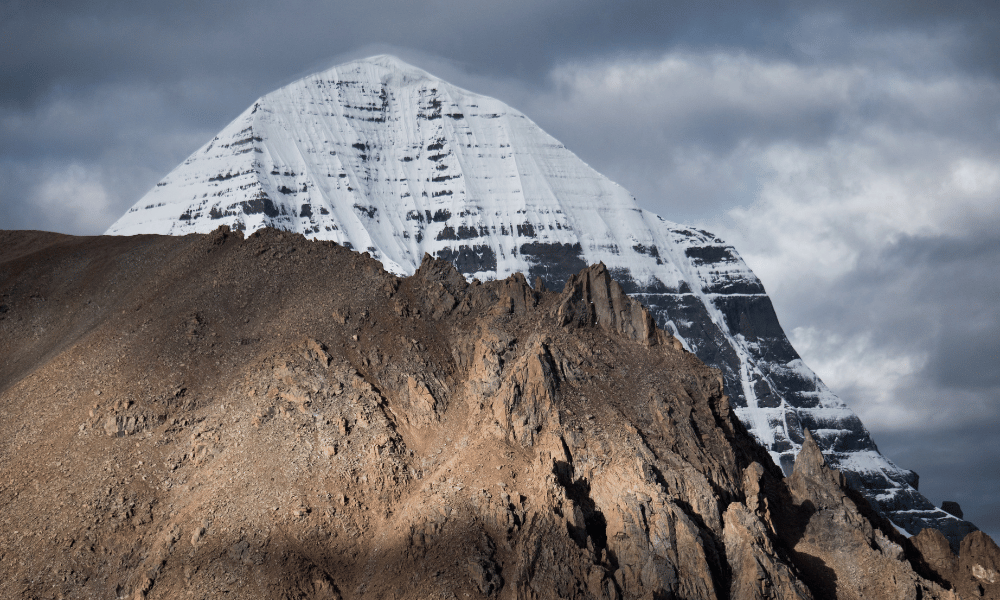
Important Dates
While the specific dates can vary each year, here's a general timeline:
-
Applications usually open around February.
-
The application process typically continues for about a month.
-
The draw of lots for selection of Yatris usually takes place around April.
Again, it's important to check the most recent dates from an official source.
Other Legal Requirements for International Tourists
-
Visa: International tourists will need to secure a Chinese visa. Tour agencies can typically assist with this process.
-
Travel Insurance: It's recommended to have a comprehensive travel insurance policy that covers high-altitude trekking and emergency evacuation.
-
Fitness Certificate: All Yatris, including international tourists, need to produce a medical fitness certificate. This is to ensure that the pilgrim is fit to endure the strenuous conditions of the Yatra.
-
Passport: A valid passport with at least six months validity from the date of entry into Tibet/China is required.
The guidelines and requirements can change, so it's crucial to verify the current rules with official sources or a reliable tour agency when planning your Yatra. Compliance with all regulations will ensure a smoother and safer pilgrimage.
Conclusion
Planning your journey for the Kailash Mansarovar Yatra can be a complex task, given the region's high altitude, volatile weather conditions, and unique geographical features. However, understanding these aspects and their implications on your travel plans will help you make the most of your spiritual journey.
To recap, the Yatra is a significant pilgrimage for many religions, symbolizing a quest for self-discovery, spiritual enlightenment, and a connection to the divine. Its geographical location, nestled high in the Tibetan Himalayas, adds to its mystique and allure.
The best time to undertake this journey is typically between June and September, with each season presenting its unique pros and cons. Packing appropriately for the season, maintaining a high level of physical fitness, being aware of the signs of altitude sickness, and adhering to legal requirements are key aspects to consider.
As you embark on this incredible journey, remember that it's not just a physical trek but also a spiritual odyssey. It's a pilgrimage that challenges you, pushes your boundaries, and ultimately, leads you to a deeper understanding of yourself and the universe around you.
For many, the Kailash Mansarovar Yatra is a journey of a lifetime, one that leaves them with profound spiritual experiences and memories to cherish. May your journey to this sacred land be filled with awe-inspiring views, personal growth, and spiritual fulfillment. Safe travels!
Travelers Also Ask
When is the Kailash Mansarovar Yatra usually open?
The Yatra usually opens between May and October, depending on the weather conditions. The exact dates may vary each year.
What is the best time to undertake the Kailash Mansarovar Yatra?
The best time to undertake the Yatra is typically between June and September. These months offer more stable weather conditions and clear trekking routes.
Can I go on the Kailash Mansarovar Yatra during winter?
The Yatra is usually closed during the winter months (late October to early March) due to extreme weather conditions, heavy snowfall, and inaccessible routes. It is also very dangerous to attempt the Yatra during this period.
How is the weather during the Yatra?
The weather during the Yatra can be quite volatile, with temperatures varying widely between day and night. Even during the summer months, temperatures can drop to around 0°C at night, while daytime temperatures can reach up to 15°C. The region also experiences monsoon between June and August.
Is the Yatra crowded during the best time to visit?
Yes, the Yatra can be quite crowded during the peak months of June to August. If you prefer fewer crowds, you might want to consider going in the later part of the season, such as in September.
How can I prepare for the changing weather conditions during the Yatra?
Packing appropriately is crucial for dealing with changing weather conditions. This includes layering your clothing, carrying rainproof and cold-weather gear, and having a good quality, sturdy pair of trekking shoes. Hydration and acclimatization are also very important.
What precautions should I take to prevent altitude sickness during the Yatra?
To prevent altitude sickness, it's important to acclimatize properly, stay well-hydrated, and maintain a balanced diet. If you start experiencing symptoms like headache, dizziness, or nausea, you should rest and avoid ascending further. If symptoms persist or worsen, you should descend to a lower altitude and seek medical attention immediately.


